The Rice Bran Oil for Skin Care Market is expected to record a valuation of USD 1,303.1 million in 2025 and USD 4,203.4 million in 2035, with an increase of USD 2,900.3 million, which equals a growth of 193% over the decade. The overall expansion represents a CAGR of 12.4% and a 3.2X increase in market size.
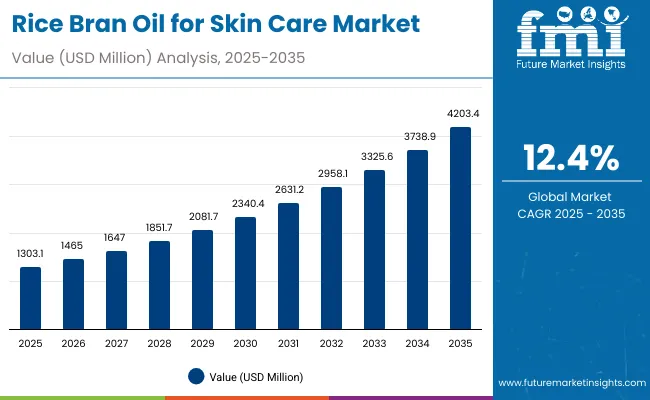
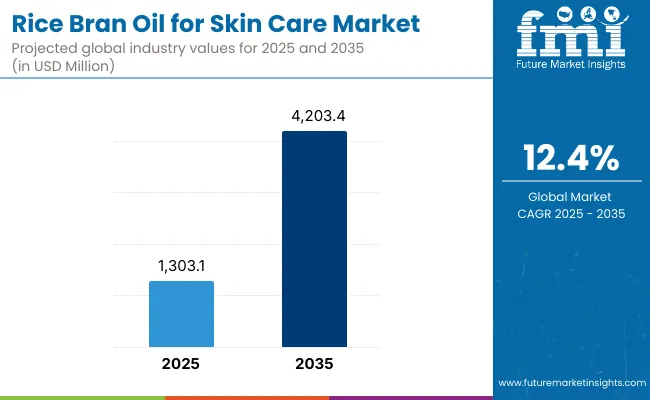
Rice Bran Oil for Skin Care Market Key Takeaways
| Metric | Value |
|---|---|
| Rice Bran Oil for Skin Care Market Estimated Value in (2025E) | USD 1,303.1 million |
| Rice Bran Oil for Skin Care Market Forecast Value in (2035F) | USD 4,203.4 million |
| Forecast CAGR (2025 to 2035) | 12.4% |
During the first five-year period from 2025 to 2030, the market increases from USD 1,303.1 million to USD 2,340.4 million, adding USD 1,037.3 million, which accounts for 36% of the total decade growth. This phase records steady adoption across natural/organic skincare, antioxidant repair formulations, and premium-grade oils, with strong penetration through serums, facial oils, and creams/lotions. Cold-pressed/virgin grade oils and natural/organic claims dominate this period, each accounting for nearly half of global demand.
The second half from 2030 to 2035 contributes USD 1,863.0 million, equal to 64% of total growth, as the market jumps from USD 2,340.4 million to USD 4,203.4 million. This acceleration is powered by premium dermocosmetics, AI-personalized skincare, and expanding Asian beauty retail ecosystems.
Widespread adoption in e-commerce and specialty channels boosts accessibility, while natural/organic and antioxidant-rich claims strengthen brand positioning. By 2035, China, India, and Japan emerge as the fastest-growing markets, with China alone reaching USD 137.3 million in 2025 and expanding at a 19.2% CAGR.
From 2020 to 2024, the Rice Bran Oil for Skin Care Market expanded steadily as demand for botanical-based moisturizers, antioxidant-rich formulations, and clean-label products increased. Growth during this period was primarily driven by hardware-like dominance of cold-pressed/virgin oils and creams/lotions, which controlled nearly 50% of revenues.
Leading brands such as DHC, Kose, and The Ordinary gained competitive advantage through premium positioning, visible results, and expanding Asian beauty influence. Differentiation relied on purity, clinical validation, and affordability, while niche service-based or custom-blend offerings contributed minimally to market value.
By 2025, the market value will expand to USD 1,303.1 million, and the revenue mix will shift toward natural/organic and antioxidant-repair formulations, together making up more than 50% share. Traditional Japanese and Korean beauty leaders face rising competition from digital-first brands leveraging AI-personalized skincare, online subscription services, and clean beauty ecosystems. Competitive advantage is moving away from single-product performance to ecosystem strength, omnichannel reach, and recurring revenue streams through e-commerce and specialty retail.
A major driver of growth is the increasing use of rice bran oil in anti-aging formulations due to its high concentration of γ-oryzanol and tocopherols, which deliver clinically recognized antioxidant and skin-repair benefits. Brands are leveraging these bioactive compounds to position products as effective alternatives to synthetic antioxidants. This unique functional profile is fueling adoption across serums, facial oils, and dermocosmetic products, especially in Asia-Pacific and Europe where anti-aging is a core consumer priority.
The surge in online specialty platforms and Asian beauty retail ecosystems is accelerating rice bran oil adoption. South Korea, Japan, and China are integrating rice bran oil into mainstream K-beauty and J-beauty routines, driving consumer trust and mass-market visibility.
With e-commerce offering global reach, niche brands can position cold-pressed and organic-certified rice bran oil products directly to eco-conscious consumers. This digital-first distribution strategy is significantly boosting market penetration and long-term loyalty beyond traditional offline channels.
The Rice Bran Oil for Skin Care Market is segmented by function, product type, grade, claim, channel, and region. Functions include antioxidant/repair, moisturizing, brightening, and soothing, highlighting the diverse skin benefits driving adoption. Product type segmentation spans facial oils, serums, creams/lotions, and cleansers/balms, reflecting wide application in daily skincare.
Grades cover cold-pressed/virgin, refined cosmetic grade, and organic-certified, each targeting distinct consumer groups. Claims such as natural/organic, vegan, clean-label, and fragrance-free strengthen brand positioning among eco-conscious users.
Distribution channels include e-commerce, Asian beauty specialty, pharmacies, and mass retail, underlining omni-channel reach. Regionally, the scope covers North America, Europe, and Asia-Pacific, with country-level focus on the United States, China, Japan, Germany, the United Kingdom, and India.
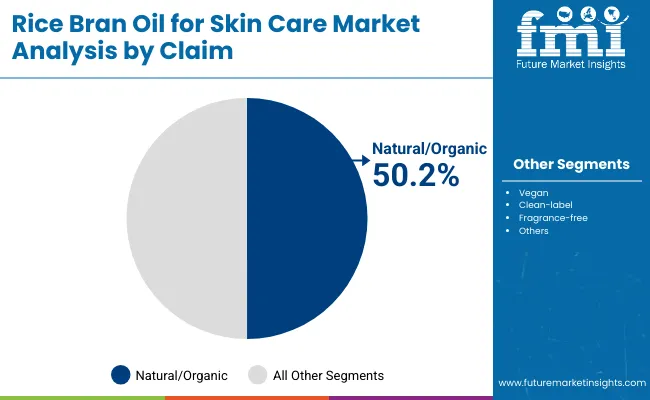
| Claim | Value Share % 2025 |
|---|---|
| Natural/organic | 50.2% |
| Others | 49.8% |
The natural/organic claim segment is projected to contribute 50.2% of Rice Bran Oil for Skin Care Market revenue in 2025, maintaining its lead as the dominant category. Growth is driven by consumer preference for botanical actives, cold-pressed extraction, and formulations free from synthetic additives. Brands are highlighting γ-oryzanol and tocopherol content as clean-label antioxidants, positioning products as both effective and sustainable.
The segment’s momentum is further supported by the rise of eco-conscious consumers in Asia-Pacific and Europe, where natural certifications and organic seals directly influence purchase decisions. With e-commerce and Asian beauty specialty channels amplifying access, natural/organic rice bran oil products are expected to remain at the forefront of innovation. This segment will continue to define the premiumization and trust factor in global skincare positioning.
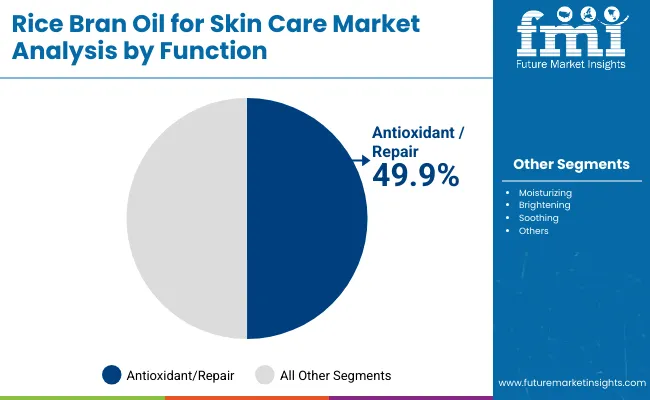
| Function | Value Share % 2025 |
|---|---|
| Antioxidant/repair | 49.9% |
| Others | 50.1% |
The antioxidant/repair segment is forecasted to hold 49.9% of the Rice Bran Oil for Skin Care Market share in 2025, driven by its effectiveness in combating oxidative stress, UV-induced damage, and premature skin aging. Rich in γ-oryzanol, tocopherols, and ferulic acid, rice bran oil is increasingly incorporated into serums and facial oils targeting anti-aging and skin-repair categories.
This segment’s strength comes from the growing demand for dermocosmetic solutions that bridge clinical efficacy and natural sourcing, particularly in Asia-Pacific markets like Japan and China where anti-aging is a top consumer priority. Adoption is also fueled by the premium skincare trend in North America and Europe, where antioxidant-rich formulations command higher price points and brand loyalty. As consumers seek multifunctional products that deliver both repair and preventive care, the antioxidant/repair segment is expected to remain a cornerstone of rice bran oil-based skincare innovation.
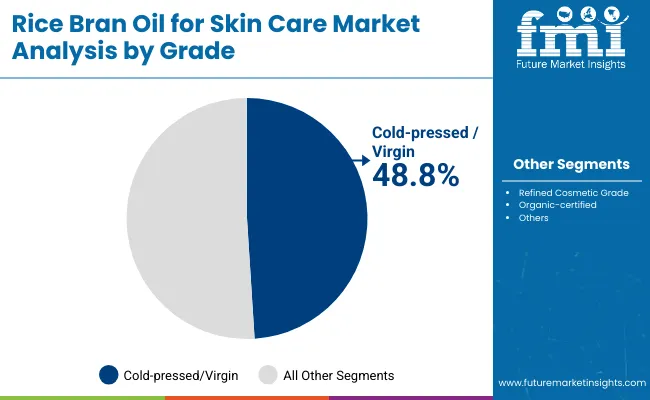
| Grade | Value Share % 2025 |
|---|---|
| Cold-pressed/virgin | 48.8% |
| Others | 51.2% |
The cold-pressed/virgin grade segment is projected to account for 48.8% of Rice Bran Oil for Skin Care Market revenue in 2025, positioning it as the leading grade type. This dominance is attributed to the preservation of natural antioxidants, vitamins, and fatty acids during extraction, which enhances skin-repair and moisturizing benefits. Consumers perceive cold-pressed oils as higher quality and more authentic, supporting their premium positioning in facial oils, serums, and organic-certified skincare.
Adoption is further supported by the clean-label and eco-conscious movement, where cold-pressed/virgin formulations carry greater trust and command price premiums across both Asian and Western markets. As demand for minimally processed and nutrient-rich skincare ingredients rises, the cold-pressed/virgin segment is expected to sustain leadership, driving innovation in antioxidant-focused and natural/organic product launches.
Rising Demand for Antioxidant-Rich Anti-Aging Solutions
The increasing prevalence of premature aging, UV exposure, and oxidative stress is fueling demand for rice bran oil in anti-aging skincare. Its high concentration of γ-oryzanol, tocopherols, and ferulic acid provides strong antioxidant properties that repair and protect skin. This makes it highly attractive for dermocosmetic brands positioning natural ingredients as alternatives to synthetic actives. With anti-aging being one of the fastest-growing skincare categories worldwide, rice bran oil is gaining strong traction among both premium and mass-market formulations.
Expansion of E-commerce and Asian Beauty EcosystemsE-commerce growth and the global influence of Asian beauty (K-beauty and J-beauty) are driving rice bran oil’s adoption. Digital-first distribution platforms allow niche natural/organic formulations to reach international consumers, while established Asian skincare brands integrate rice bran oil into mainstream serums, lotions, and facial oils.
The combination of online specialty retailers, subscription-based models, and cross-border shipping is expanding product accessibility. This dynamic channel expansion is not only increasing consumer awareness but also enabling smaller players to compete effectively against established global brands.
Limited Consumer Awareness Outside Asia-Pacific
While rice bran oil is well recognized in Asian markets, awareness in North America and parts of Europe remains limited compared to more established natural oils like argan or jojoba. Many consumers are unfamiliar with its bioactive profile, reducing adoption in mainstream products.
Marketing challenges, coupled with the need for consumer education on γ-oryzanol and tocopherol benefits, have slowed penetration in new regions. Without consistent brand storytelling and dermatologist endorsements, rice bran oil risks lagging behind other botanical oils in global visibility.
Premiumization Through Cold-Pressed and Organic CertificationA key trend reshaping the market is the premiumization of rice bran oil through cold-pressed extraction and organic certification. Consumers are increasingly associating these qualities with purity, efficacy, and sustainability, which directly influence purchasing decisions in skincare.
Cold-pressed oils retain higher concentrations of antioxidants and fatty acids, while organic seals provide trust for eco-conscious buyers. Brands are highlighting these attributes in product marketing, especially in facial oils and serums, to differentiate themselves. This trend is fueling higher margins and strengthening brand loyalty in competitive markets.
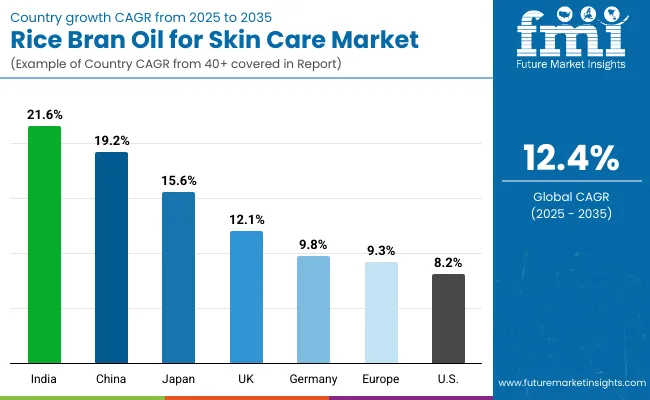
| Country | Estimated CAGR (2025 to 2035) |
|---|---|
| China | 19.2% |
| USA | 8.2% |
| India | 21.6% |
| UK | 12.1% |
| Germany | 9.8% |
| Japan | 15.6% |
The global Rice Bran Oil for Skin Care Market shows notable variation in growth by country, shaped by consumer awareness, beauty culture, and distribution ecosystems. Asia-Pacific dominates growth, led by India at 21.6% CAGR and China at 19.2% CAGR, where strong demand for natural, antioxidant-rich oils aligns with rising disposable incomes and deep integration into K-beauty and J-beauty routines. Japan follows with a 15.6% CAGR, reflecting its mature dermocosmetic landscape and innovation-led premium skincare segment.
In Europe, the UK (12.1%) and Germany (9.8%) are advancing steadily as clean-label, organic-certified oils gain traction, supported by strong consumer awareness of botanical actives and regulatory emphasis on natural cosmetics. North America, led by the USA at 8.2% CAGR, shows more measured growth, with rice bran oil gaining adoption primarily through e-commerce, indie beauty brands, and premium organic product lines. While growth is slower compared to Asia-Pacific, rising demand for vegan, fragrance-free, and multi-functional oils positions the USA as an important future market.

| Year | USA Rice Bran Oil for Skin Care Market (USD Million) |
|---|---|
| 2025 | 257.29 |
| 2026 | 287.31 |
| 2027 | 320.83 |
| 2028 | 358.27 |
| 2029 | 400.07 |
| 2030 | 446.75 |
| 2031 | 498.88 |
| 2032 | 557.09 |
| 2033 | 622.09 |
| 2034 | 694.68 |
| 2035 | 775.73 |
The Rice Bran Oil for Skin Care Market in the United States is projected to grow at a CAGR of 8.2% between 2025 and 2035, reaching USD 775.7 million by 2035. Growth is led by rising adoption of natural/organic claims, which account for over 50% share in 2025, supported by consumer awareness of antioxidant benefits and dermatologist endorsements. Premium facial oils, serums, and creams/lotions are the most dynamic categories, while clean-label and vegan-certified products are gaining popularity among eco-conscious buyers.
The Rice Bran Oil for Skin Care Market in the United Kingdom is expected to grow at a CAGR of 12.1% between 2025 and 2035, supported by strong consumer demand for natural, clean-label, and antioxidant-rich formulations. Premium skincare brands are incorporating rice bran oil into facial oils, serums, and moisturizers, emphasizing its γ-oryzanol and tocopherol content for anti-aging and skin-repair benefits. Growth is also driven by rising availability through e-commerce, pharmacies, and specialty beauty retailers, enabling broader access across demographics.
The UK market benefits from organic certifications and sustainability-driven purchasing, aligning with consumer priorities for eco-friendly skincare solutions. Additionally, local innovation hubs and collaborations between beauty startups and established retailers are expanding rice bran oil’s presence in both mass and premium categories.
India is witnessing rapid growth in the Rice Bran Oil for Skin Care Market, which is forecast to expand at a CAGR of 21.6% through 2035. Demand is being fueled by rising middle-class disposable incomes, expanding beauty retail penetration, and cultural acceptance of plant-based oils in personal care. Tier-2 and tier-3 cities are emerging as strong growth hubs, where increased affordability and e-commerce access are making premium skincare more attainable.
Domestic and international brands are incorporating rice bran oil into moisturizers, creams, and facial oils, highlighting its antioxidant and moisturizing benefits. Educational awareness campaigns and dermatologist recommendations are further boosting consumer trust. Additionally, India’s growing preference for organic-certified and vegan skincare is creating opportunities for niche and premium players to scale quickly.
The Rice Bran Oil for Skin Care Market in China is expected to grow at a CAGR of 19.2%, the highest among leading economies, making it one of the most dynamic markets globally. This momentum is driven by the rapid rise of K-beauty and J-beauty inspired skincare, government support for natural cosmetics, and the strong presence of domestic e-commerce platforms. Local and international brands are actively launching antioxidant-rich serums, moisturizing creams, and facial oils featuring rice bran oil as a hero ingredient.
Chinese consumers are increasingly prioritizing natural, organic, and clean-label claims, aligning with health and wellness trends. Affordable yet premium-positioned rice bran oil formulations from domestic brands are enabling adoption across urban and semi-urban centers. Digital-first distribution and cross-border e-commerce platforms are amplifying reach, while partnerships with Asian beauty specialty retailers accelerate market penetration.
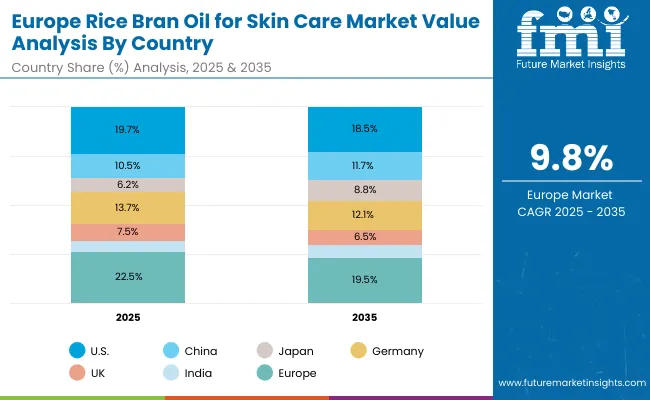
| Country | 2025 Share (%) |
|---|---|
| USA | 19.7% |
| China | 10.5% |
| Japan | 6.2% |
| Germany | 13.7% |
| UK | 7.5% |
| India | 4.7% |
| Country | 2035 Share (%) |
|---|---|
| USA | 18.5% |
| China | 11.7% |
| Japan | 8.8% |
| Germany | 12.1% |
| UK | 6.5% |
| India | 5.3% |
The Rice Bran Oil for Skin Care Market in Germany is projected to grow at a CAGR of 9.8% between 2025 and 2035, with its market share gradually moderating from 13.7% in 2025 to 12.1% in 2035. Growth is underpinned by Germany’s strong consumer preference for organic-certified, vegan, and clean-label skincare products, aligning with the country’s sustainability-driven beauty culture. Premium brands are incorporating rice bran oil into anti-aging creams, moisturizers, and serums, capitalizing on its antioxidant profile and eco-friendly sourcing.
Pharmacies and drugstore chains such as dm and Rossmann remain critical distribution hubs, while e-commerce channels are expanding adoption among younger demographics. Regulatory frameworks supporting natural cosmetics certification (e.g., NATRUE, COSMOS) enhance consumer trust and reinforce demand for cold-pressed and organic-grade rice bran oil products. Germany’s market will continue to be a key European hub, especially for premium and eco-conscious skincare innovation.

| USA by Claim | Value Share % 2025 |
|---|---|
| Natural/organic | 50.2% |
| Others | 49.8% |
The Rice Bran Oil for Skin Care Market in the United States is projected at USD 257.3 million in 2025, expanding to USD 775.7 million by 2035 at a CAGR of 8.2%. The natural/organic claim segment leads with 50.2% share in 2025, reflecting strong consumer demand for clean-label, eco-friendly, and dermatologist-endorsed skincare. This balance between natural/organic and conventional claims highlights the USA market’s shift toward sustainable beauty preferences.
Growth is supported by the increasing adoption of antioxidant-rich serums, facial oils, and moisturizers, as consumers seek alternatives to synthetic actives for anti-aging and repair. Premium skincare brands are emphasizing rice bran oil’s unique γ-oryzanol and tocopherol profile, while indie and direct-to-consumer brands are leveraging e-commerce platforms to build loyal consumer bases. Distribution through pharmacies, specialty beauty stores, and online channels ensures broad reach, reinforcing the USA as a key market in the global expansion of rice bran oil-based skincare.
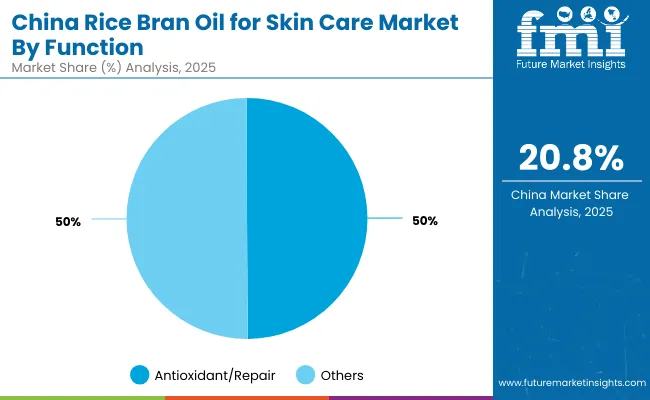
| China by Function | Value Share % 2025 |
|---|---|
| Antioxidant/repair | 49.9% |
| Others | 50.1% |
The Rice Bran Oil for Skin Care Market in China is projected at USD 137.3 million in 2025, expanding rapidly at a CAGR of 19.2%, the highest among leading economies. The antioxidant/repair segment dominates with 49.9% share, supported by rising demand for anti-aging serums, moisturizers, and brightening formulations. China’s beauty culture strongly favors multi-functional, natural oils that combine repair, brightening, and soothing properties, positioning rice bran oil as a versatile ingredient in both mass-market and premium categories.
Opportunities are amplified by the country’s robust e-commerce platforms (Tmall, JD.com, Douyin) and the strong penetration of Asian beauty specialty retailers, which give both local startups and global players a wide distribution reach. Additionally, Chinese consumers show growing trust in organic-certified, vegan, and clean-label products, allowing rice bran oil-based skincare to capture premium pricing. As K-beauty and J-beauty trends continue to influence local consumption, brands highlighting γ-oryzanol and tocopherol content can differentiate strongly in the competitive market.

| Company | Global Value Share 2025 |
|---|---|
| DHC | 8.1% |
| Others | 91.9% |
The Rice Bran Oil for Skin Care Market is moderately fragmented, with Japanese and Korean beauty giants, global skincare multinationals, and niche natural/organic specialists competing across categories. DHC, holding 8.1% global share in 2025, leads the market through its integration of rice bran oil in facial oils, cleansers, and serums, supported by strong branding around antioxidant and moisturizing properties. Established Asian brands such as Kose, Shiseido, HadaLabo, Innisfree, and Rohto emphasize rice bran oil’s role in anti-aging, brightening, and moisturizing formulations, often combining it with hyaluronic acid and botanical actives for multifunctional skincare. Western brands like The Ordinary, Tatcha, and Kiehl’s leverage minimalist, clean-label, and premium positioning to expand adoption across North America and Europe.
Emerging niche players such as Haeckels are driving growth in the organic-certified, vegan, and eco-conscious skincare space, appealing to sustainability-focused consumers. Competitive differentiation is shifting from single-ingredient marketing toward ecosystem positioning, where claims such as organic-certified, cold-pressed, and fragrance-free are bundled with personalized skincare routines and e-commerce subscription models.
Key Developments in Rice Bran Oil for Skin Care Market
| Item | Value |
|---|---|
| Quantitative Units | USD 1,303.1 Million |
| Function | Antioxidant/repair (γ- oryzanol , tocopherols), Moisturizing, Brightening, Soothing |
| Product Type | Facial oils, Serums, Creams/lotions, Cleansers/balms |
| Grade | Cold-pressed/virgin, Refined cosmetic grade, Organic-certified |
| Channel | E-commerce, Asian beauty specialty, Pharmacies, Mass retail |
| Claim | Natural/organic, Vegan, Clean-label, Fragrance-free |
| Regions Covered | North America, Europe, Asia-Pacific, Latin America, Middle East & Africa |
| Country Covered | United States, Canada, Germany, France, United Kingdom, China, Japan, India, Brazil, South Africa |
| Key Companies Profiled | DHC, Kose , Tatcha , Hada Labo , The Ordinary, Kiehl’s , Innisfree, Shiseido, Rohto, Haeckels |
| Additional Attributes | Dollar sales by claim (natural/organic vs others), function (antioxidant/repair, moisturizing, brightening, soothing), grade (cold-pressed/virgin, refined, organic-certified), product type (facial oils, serums, creams/lotions, cleansers/balms), and channel (e-commerce, Asian beauty specialty, pharmacies, mass retail). Growth is supported by demand for cold-pressed and organic-certified formulations, premiumization via γ- oryzanol and tocopherol, AI-personalized skincare and D2C subscriptions, strong Asia-Pacific momentum (China/India), regulatory trust through COSMOS/NATRUE, and sustainability via upcycled rice by-product sourcing. |
The global Rice Bran Oil for Skin Care Market is estimated to be valued at USD 1,303.1 million in 2025.
The market size for the Rice Bran Oil for Skin Care Market is projected to reach USD 4,203.4 million by 2035.
The Rice Bran Oil for Skin Care Market is expected to grow at a 12.4% CAGR between 2025 and 2035.
The key product types in the Rice Bran Oil for Skin Care Market are facial oils, serums, creams/lotions, and cleansers/balms.
In terms of grade, the cold-pressed/virgin segment is expected to contribute a significant share of 48.8% in the Rice Bran Oil for Skin Care Market in 2025, supported by consumer preference for minimally processed, nutrient-rich formulations with higher antioxidant content.






Full Research Suite comprises of:
Market outlook & trends analysis
Interviews & case studies
Strategic recommendations
Vendor profiles & capabilities analysis
5-year forecasts
8 regions and 60+ country-level data splits
Market segment data splits
12 months of continuous data updates
DELIVERED AS:
PDF EXCEL ONLINE
Rice Shampoo Bar Market Size and Share Forecast Outlook 2025 to 2035
Rice Milling Machine Market Size and Share Forecast Outlook 2025 to 2035
Rice Mill Machine Market Size and Share Forecast Outlook 2025 to 2035
Rice Derivative Market Size and Share Forecast Outlook 2025 to 2035
Rice Polishing Machines Market Size and Share Forecast Outlook 2025 to 2035
Rice Water Shampoo Market Size and Share Forecast Outlook 2025 to 2035
Rice Processing Machine Market Size and Share Forecast Outlook 2025 to 2035
Rice Cake Market Analysis - Size, Share, and Forecast Outlook 2025 to 2035
Rice Milk Market Trends - Dairy-Free Nutrition & Industry Growth 2025 to 2035
Rice-based Products Market Analysis by Product Type, Distribution Channel, and Region Through 2035
Market Share Breakdown of Rice Shampoo Bar Manufacturers
Rice Paper Stand Up Pouch Market Growth & Sustainable Packaging 2024-2034
Rice Protein Market
Rice Water Haircare Market Size and Share Forecast Outlook 2025 to 2035
Key Players & Market Share in Rice Water Haircare Sector
Rice Water Skincare Market Forecast and Outlook 2025 to 2035
Rice Bran Fatty Alcohols Market Size and Share Forecast Outlook 2025 to 2035
Rice Bran Derivatives Market Size and Share Forecast Outlook 2025 to 2035
Rice Bran Wax Market Analysis - Size, Share, and Forecast 2025 to 2035
Rice Bran Oil Infusions Market Analysis - Size and Share Forecast Outlook 2025 to 2035

Thank you!
You will receive an email from our Business Development Manager. Please be sure to check your SPAM/JUNK folder too.
Chat With
MaRIA